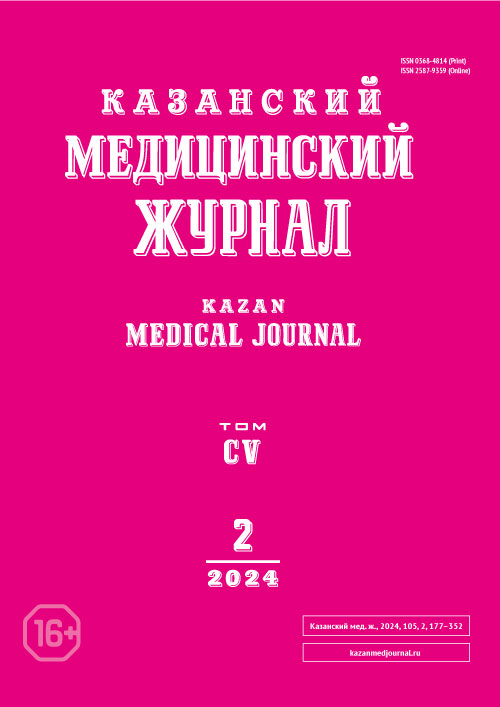Evaluation of angiogenesis and microvascular remodeling in the subventricular zone of the brain of mice with experimental Alzheimer’s disease
- Authors: Averchuk A.S.1, Ryazanova M.V.1, Stavrovskaya A.V.1, Novikova S.V.1, Salmina A.B.1
-
Affiliations:
- Research Center of Neurology
- Issue: Vol 105, No 2 (2024)
- Pages: 231-239
- Section: Experimental medicine
- Submitted: 19.06.2023
- Accepted: 25.01.2024
- Published: 01.04.2024
- URL: https://kazanmedjournal.ru/kazanmedj/article/view/501749
- DOI: https://doi.org/10.17816/KMJ501749
- ID: 501749
Cite item
Abstract
BACKGROUND: Under the influence of external factors (learning), processes of microvasculature remodeling occur in the neurogenic niche to meet the metabolic needs of activated cells. However, it remains unclear how these mechanisms of brain plasticity are disrupted during neurodegeneration.
AIM: To study the expression features of markers of angiogenesis and microvascular remodeling in the subventricular zone of the brain during training of animals, including against the background of the development of Alzheimer’s-type neurodegeneration in them.
MATERIAL AND METHODS: The studies were carried out on C57BL/6 mice at the age of 8 months. Modeling of Alzheimer’s disease was carried out by intrahippocampal injection of 2 μl of a 1 mM solution of β-amyloid Aβ25-35. To assess cognitive deficits, a conditioned passive avoidance test using an aversive stimulus was used. The expression of LC3B, ZO1, VEGFR2, VEGFR3, CD146, ICAM2, Dll4, Tie2 in the subventricular zone per 100 DAPI-positive cells was assessed. The test results were processed using one-way ANOVA and Fisher's test, the Mann–Whitney U test, the results were considered significant at p <0.05.
RESULTS: On the 9th day after the administration of β-amyloid, before the application of the aversive stimulus, an increase in the expression level of LC3 (7.95±5.83%, p=0.045), CD146 (18.35±0.01%, p=0.045) was recorded, as well as VEGFR3 (17.13±5.05%, p=0.045), which continued to increase after the presentation of the stimulus (26.61±0.01%, p=0.045). By the beginning of registration of cognitive impairment (38th day of the experiment), the expression level of VEGFR2 (20.61±2.8%, p=0.045) and ICAM2 (126.61±41.28%, p=0.045) increased, the content of Dll4 (29.66±8.72%, p=0.045) and Tie2 (36.39±7.8%, p=0.045) decreased in animals with experimental Alzheimer’s disease.
CONCLUSION: An aversive stimulus stimulates microvascular remodeling mechanisms in the subventricular zone of the animal’s brain, but when exposed to β-amyloid, these processes are significantly disrupted.
Full Text
About the authors
Anton S. Averchuk
Research Center of Neurology
Author for correspondence.
Email: antonaverchuk@yandex.ru
ORCID iD: 0000-0002-1284-6711
SPIN-code: 7276-8713
Scopus Author ID: 57204197597
ResearcherId: I-1075-2018
Cand. Sci. (Biol.), Assoc. Prof., Researcher, Laboratory of Neurobiology and Tissue Engineering, Brain Science Institute
Russian Federation, MoscowMaria V. Ryazanova
Research Center of Neurology
Email: mashenka.ryazanova@list.ru
ORCID iD: 0000-0003-0700-4912
Postgrad. Stud., Laboratory of Neurobiology and Tissue Engineering, Brain Science Institute
Russian Federation, MoscowAlla V. Stavrovskaya
Research Center of Neurology
Email: alla_stav@mail.ru
ORCID iD: 0000-0002-8689-0934
Cand. Sci. (Biol.), Head, Laboratory of Experimental Pathology of the Nervous System, Brain Science Institute
Russian Federation, MoscowSvetlana V. Novikova
Research Center of Neurology
Email: levik_82@mail.ru
ORCID iD: 0009-0008-3905-1928
Junior Researcher, Laboratory of Experimental Pathology of the Nervous System, Brain Science Institute
Russian Federation, MoscowAlla B. Salmina
Research Center of Neurology
Email: allasalmina@mail.ru
ORCID iD: 0000-0003-4012-6348
M.D., D. Sci. (Med), Prof., Chief Researcher, Head, Laboratory of Experimental Pathology of the Nervous System, Brain Science Institute
Russian Federation, MoscowReferences
- Bogorad MI, DeStefano JG, Linville RM, Wong AD, Searson PC. Cerebrovascular plasticity: Processes that lead to changes in the architecture of brain microvessels. J Cereb Blood Flow Metab. 2019;39(8):1413–1432. doi: 10.1177/0271678X19855875.
- Ryazanova MV, Averchuk AS, Novikova SV, Salmina AB. Molecular mechanisms of angiogenesis: Brain is in the focus. Opera Medica et Physiologica. 2022;9(2):54–72. doi: 10.24412/2500-2295-2022-2-54-72.
- Tregub PP, Averchuk AS, Baranich TI, Ryazanova MV, Salmina AB. Physiological and pathological remodeling of cerebral microvessels. Int J Mol Sci. 2022;23(20):12683. doi: 10.3390/ijms232012683.
- Cutler RR, Kokovay E. Rejuvenating subventricular zone neurogenesis in the aging brain. Curr Opin Pharmacol. 2020;50:1–8. doi: 10.1016/j.coph.2019.10.005.
- Lin R, Cai J, Nathan C, Wei X, Schleidt S, Rosenwasser R, Iacovitti L. Neurogenesis is enhanced by stroke in multiple new stem cell niches along the ventricular system at sites of high BBB permeability. Neurobiol Dis. 2015;74:229–239. doi: 10.1016/j.nbd.2014.11.016.
- Steinman J, Sun HS, Feng ZP. Microvascular alterations in Alzheimer's disease. Front Cell Neurosci. 2021;14:618986. doi: 10.3389/fncel.2020.618986.
- Dong X, Wang YS, Dou GR, Hou HY, Shi YY, Zhang R, Ma K, Wu L, Yao LB, Cai Y, Zhang J. Influence of Dll4 via HIF-1α-VEGF signaling on the angiogenesis of choroidal neovascularization under hypoxic conditions. PLoS One. 2011;6(4):e18481. doi: 10.1371/journal.pone.0018481.
- Averchuk AS, Ryazanova MV, Baranich TI, Stavrovskaya AV, Rozanova NA, Novikova SV, Salmina AB. The neurotoxic effect of beta-amyloid is accompanied with changes in the mitochondrial dynamics and autophagy in neurons and brain endothelial cells in the experimental model of Alzheimer’s disease. Bulletin Exper Biol Med. 2023;175(3):291–297. (In Russ.) doi: 10.47056/0365-9615-2023-175-3-291-297.
- Amsellem V, Dryden NH, Martinelli R, Gavins F, Almagro LO, Birdsey GM, Haskard DO, Mason JC, Turowski P, Randi AM. ICAM-2 regulates vascular permeability and N-cadherin localization through ezrin-radixin-moesin (ERM) proteins and Rac-1 signalling. Cell Commun Signal. 2014;12:12. doi: 10.1186/1478-811X-12-12.
- Pang D, Wang L, Dong J, Lai X, Huang Q, Milner R, Li L. Integrin α5β1-Ang1/Tie2 receptor cross-talk regulates brain endothelial cell responses following cerebral ischemia. Exp Mol Med. 2018;50(9):1–12. doi: 10.1038/s12276-018-0145-7.
- Wang X, Bove AM, Simone G, Ma B. Molecular bases of VEGFR-2-mediated physiological function and pathological role. Front Cell Dev Biol. 2020;8:599281. doi: 10.3389/fcell.2020.599281.
- Heinolainen K, Karaman S, D'Amico G et al. VEGFR3 modulates vascular permeability by controlling VEGF/VEGFR2 signaling. Circ Res. 2017;120(9):1414–1425. doi: 10.1161/CIRCRESAHA.116.310477.
- Moritz F, Schniering J, Distler JHW et al. Tie2 as a novel key factor of microangiopathy in systemic sclerosis. Arthritis Res Ther. 2017;19(1):105. doi: 10.1186/s13075-017-1304-2.
- González-Salinas S, Medina AC, Alvarado-Ortiz E, Antaramian A, Quirarte GL, Prado-Alcalá RA. Retrieval of inhibitory avoidance memory induces differential transcription of arc in striatum, hippocampus, and amygdala. Neuroscience. 2018;382:48–58. doi: 10.1016/j.neuroscience.2018.04.031.
- Lobov I, Mikhailova N. The role of Dll4/notch signaling in normal and pathological ocular angiogenesis: Dll4 controls blood vessel sprouting and vessel remodeling in normal and pathological conditions. J Ophthalmol. 2018;2018:3565292. doi: 10.1155/2018/3565292.
Supplementary files










